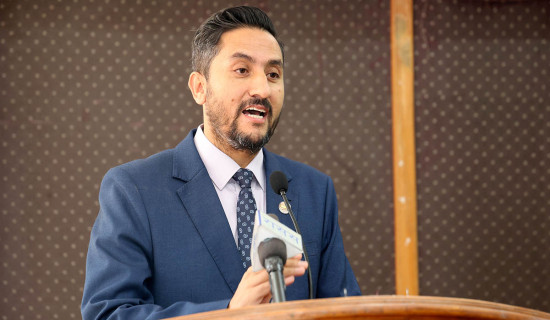- Wednesday, 17 December 2025
Electoral Shifts In Local Governance
Dev Raj Dahal
The elections of all the 753 local bodies have just been completed. The electoral battle has attracted its fervent watchers with its blips and bleeps. Nepalis now see local elections not only as the celebration of one event in the public space out of many, but a series of activities each affecting electoral outcome and the destiny of people for at least five years, if not more. The outcome of elections portent several trends of far-reaching consequences for Nepali politics -- about 42 per cent of the elected representatives are from younger generations below the age of 40.
The nation’s political heartland, Kathmandu, where critical mass is concentrated and which played pro-democracy role in the past and centripetal function to integrate the periphery, and several other municipalities are dominated by independent candidates. Others are party defectors owing to their frustrations over the top-down, hierarchic, command and control style of candidate nomination process. Out of 17,733,723 voters, about 64 per cent cast their ballots to fill 35,221 local seats. Voting turnout this time has declined from over 74 per cent in the previous local elections while invalid voting surged for reasons of lack of proper voters’ education, complicated ballot papers, certain level of people’s apathy and migration of some to the global labour market.
Electoral strategy
The Nepali Congress (NC) bounced back as the single largest scorer of seats while CPN-Maoist Centre too recuperated from its previous position and became the third largest beneficiary. Yet, the Maoist clout in Madhes has plummeted. The impressive win for NC and Maoist Centre certainly offers both dollop chances to consolidate their electoral base radically whittled down in the past. For the biggest parliamentary party CPN-UML, the electoral outcome is a bit bitter. It has lost its dominant position in the local elections for the reasons of its split, intraparty squabble, the ruling coalition parties’ electoral strategy to weaken it and general trend of Nepali voters to defeat the dominant party in each election.
Now the UM t has been reduced to second position. Like it, NC and Maoist Centre can lure aspiring leaders from other parties and create robust social support if left unity is left out for reasons of mutual distrust and history of betrayal of each other and the current coalition government continues until next federal and provincial polls. Non-partisan attachment and ideological deficits in the parties can open prospects for local leaders, cadres and voters to float around, join any party in the future and turn party politics fluid and feverish if leadership transfer to relatively younger generations is deferred.
The regional parties of Terai too lost considerable influence on voters. Janata Samajbadi Party, the fourth largest party, and other Madhes-based parties too found their political space compressed. The coalition government of diverse political parties has, however, generated some confusion and contradictions among the voters. It prompted many voters to vote for their own symbols, not the candidates of coalition partners, as decided by top leaders.
This shows the tendency of party cadres and voters to remain ignorant or exercise their conscience and defy unreasonable decisions of leadership. It signifies further loss of the capacity of leaders to impose party discipline. The drain on consultative mode of decision making without knowing the ground reality will be costly for parties. Most of the top leaders of almost all parties suffered from the effect of anti-incumbent tendency of Nepali voters. They defeated them from the wards they represent, revealing that their Kathmandu-centric stake-holding does not work in the future. Their alienation from the birth of their origin indicates voters’ frustration with the local party committees and feedback loop with the central leaders.
In the days to come, talk about democracy in the internal life of parties will grow, party reform in organisational and representative areas will mount and candidates’ ability, honesty and character will be debated in advance. One lesson for Nepali parties is that the prospect of electoral victory will be decided on the basis of candidates’ virtues, quality, grit and integrity, not just the money, muscular power, communal base and links to higher ups. The victory of the bulk of independent candidates shows that most of their supporters come from new voters and those dissatisfied with the status quo that are unbound by partisan politics and entrenched interests of special interest groups influencing the functioning of mainstream parties.
Similarly, the local elections also proved the deception of crowd psychology, a psychology deployed by Nepali leaders on the eve of elections to attract voters. It concealed the nature of ground reality for national leaders to assess from a telescopic angle on the basis of the scale of the crowd, rather than visiting the houses of voters. This lays bare the decline of voters’ earlier bandwagon bent to vote for those having winning potential, large electoral campaigns and massive display of posters. Nepali voters increasingly revealed that they prefer public goods over posturing and focus on essential priorities of social goods over leaders’ preference to construct view towers, glittering office buildings and entertaining sports to play on monumental politics.
This denotes that expansion of economic pie for people and enlargement of opportunities will be the basis of inclusive politics of the future and voters’ attraction to democracy. One positive aspect of Nepali politics is that the media and civil society have massively enthused about a deeper sense of political awareness among the people that the future as a choice for them rests not on fate predetermined by their loyalty to top level leaders but by the exercise of their democratic rights and sovereignty embedded in them. The social modernisation through media and civil society will inflict a big jolt on dynastic and patronage politics in the future as democratisation process enabled many of them to know “personal is political.” It implies that refeudalisaiton of the public sphere is corrosive of democratic politics and citizenship equality.
The surge and victory of independent candidates, their spirit and utilisation of social media and personal networks, will inspire bigger number of independents in the forthcoming national and provincial elections if mainstream leaders succumb to habit-driven attitude devoid of social learning about the nation’s shifting demographic, technological, social, economic and political landscape and imperatives of Nepali electorates. Several factors are responsible for better outcome: strong performance of mainstream parties, erosion of patronage and clientalist political culture, less ego-inflation and mutual accusation tarnishing each other’s party and leader’s image.
Intelligent candidates can easily adapt to the changing social norms and muster support from those voters who are ignored in crisis time, left behind in opportunity, looked down for their lower social and economic status or aspiring ones seeking better entitlements and opportunities. For the Nepali parties, election costs soared beyond the ceiling defined by the Election Commission. But for the truly independent candidates, people offered them both voluntary service and subtle methods of electoral support.
In Nepal, local bodies represent complex actors-local party committees, business, state institutions and civil society. They are the pipelines for the growth of future leadership. Their integrity, decency, accountability and cooperation are important for the success of local democracy and pull the development process forward. Effective governance entails citizens to participate in public life and deliberate on both the ends of governance and the means for attaining them. But in no way it can offer effectiveness in governance unless they know laws and procedures on how to operate local institutions, increase administrative efficiency, delivery of public services, coordinate with non-state, civic and state institutions for planning, implementation, supervision and evaluation of local programs including the goals of SDGs, gender equity, social inclusion and management of conflicts.
Many intermediary local formal and informal institutions have emerged in response to the failure of polity to support the collective action of local people. There are success stories of local public economy, such as small enterprise, farming of commercial products, community forestry, irrigation, cooperatives, consumer groups and petty commodity trade, etc. contributing to expand cross-bonding social capital. These innovations are essential to engage ordinary Nepalis in creating jobs, alleviating their poverty, solving long-term development needs and controlling the social vices.
Participatory process
Participatory process at the local level requires institutional incentives to cooperate and deliberate to make ordinary Nepalis aware of their rights, harness civic energies, connectivity and caring culture and prevent the capture of local democracy by national network of patrimonial elites who are the causes and consequences of macro-political instability triggered by non-political issues such as climate change, pandemic, shortage of industrial and agricultural goods, dependence on remittance, energy, imports, trade deficits, growing debt, aid and loan, among others.
When public institutions of Nepal are buffeted by the placement of weak, incompetent and selfish persons in authorities, local democracy becomes vulnerable to political decay, stasis and malfunction. Ordinary Nepalis at the grassroots level are expecting informed civic knowledge about the political process on how to vote, why to vote, engage in local party committee and shape public policy, choose suitability of production, improve public security, gain knowledge about the functions of macro institutions and leadership, their stake-holding in micro institutions so that their rights become actionable and justiceable and their empowerment can mean the dignity of life.
(Former Reader at the Department of Political Science, TU, Dahal writes on political and social issues.)
















